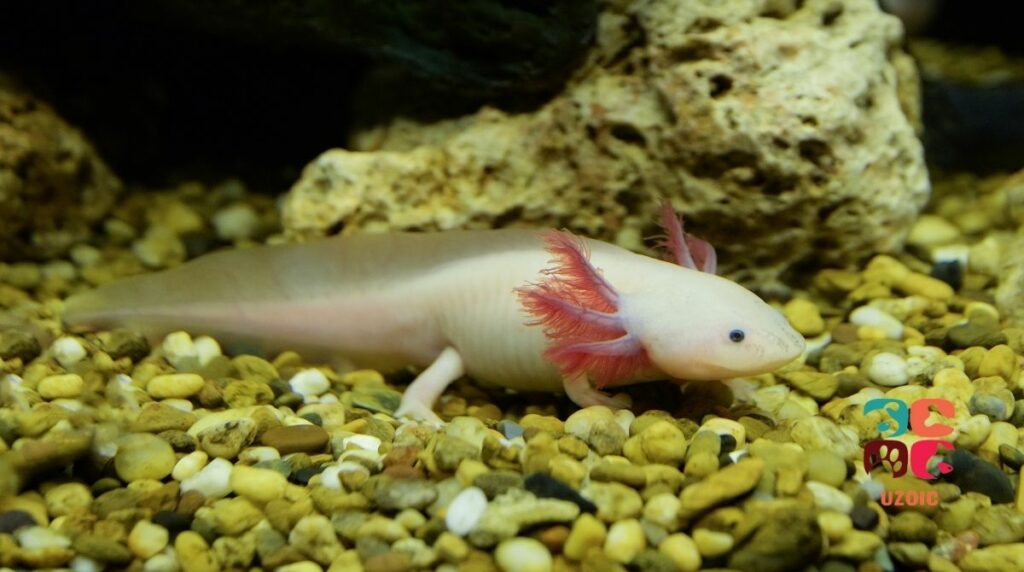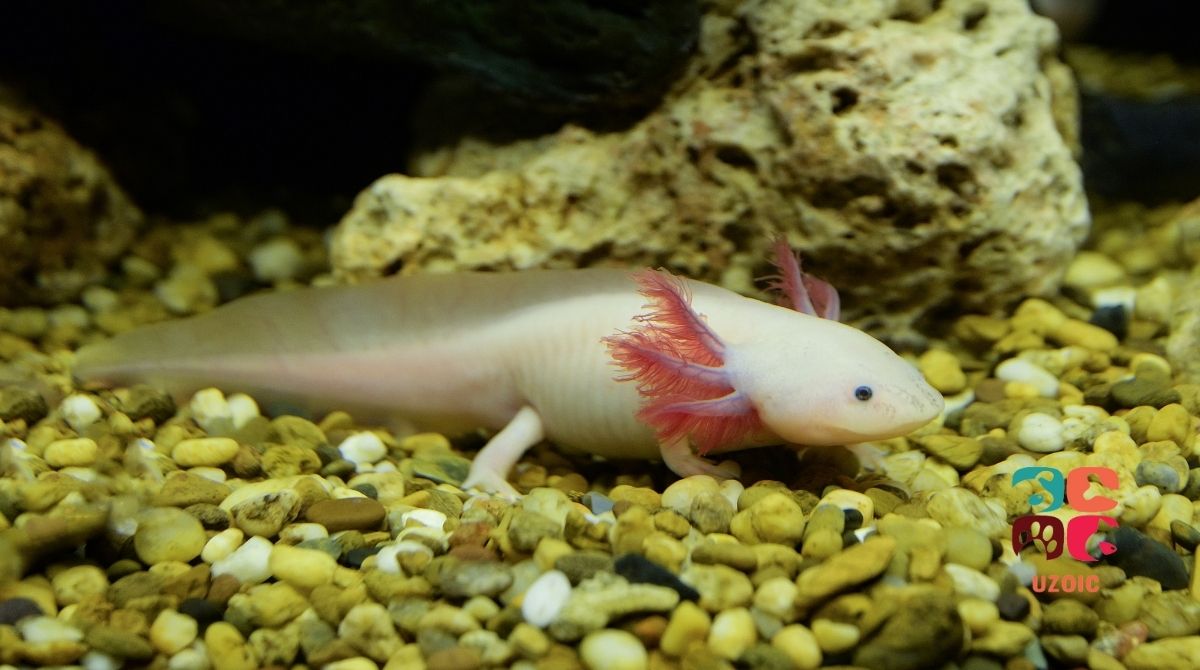Table of Contents
What Do Sick Axolotls Look Like?
Axolotl may look sick due to external or internal problems. A sick Axolotl with internal sickness will hunch and float in the water. You may observe its tail or back out of the water. These are signs that your Axolotl is sick and needs medical attention. External injuries are easier to detect. In this blog post, we will look at some common diseases and their treatment methods.
Top symptoms of sick Axolotls (Internal sickness)
- Hunch and floating in water with back or tail out
Top symptoms of sick Axolotls (External Injuries)
- Change in skin condition
- Bloating
- Puffy limbs
- Swelling
- Loss of appetite
- Physical injury
- Patches on skin
- Rotting of gills
- White fungus on gills
How Do You Know If Your Axolotl Is Sick?
You must pay attention to the symptoms displayed by the Axolotl. For internal sickness, a clear indication is a change in eating patterns. If you observe that your Axolotl is not eating right anymore, then there is something wrong with it. They normally reduce their diet or stop eating completely and this is your first indication that your Axolotl is sick. Other symptoms may develop at a later stage.
How Do Axolotls Get Sick?
Axolotls usually get sick due to infection, internal blockages, or water quality issues. Signs of diseases include floating or tilting on one side. They may appear suspended, as shown in the picture below. You can also observe your Axolotl’s back and tail. If it seems floating, hunched, or out of the water, something is probably impacting its ability to maintain equilibrium. This is usually due to water quality issues or underlying infection.
External sickness can occur due to fighting, injury, ammonia in water, or other water quality issues.
How Do I Know If Water Quality Is Making My Axolotl Sick?
If you notice rot on your Axolotls gills or if the gills are in poor condition, then the water quality is causing it. Note that your Axolotl’s gills may turn pale or white for some time, and later on, they are pink again. We have discussed this behavior in the post Why Are My Axolotls Gills Turning White?
Poor water quality will have a visible effect on their gills which you will notice.
How Do You Treat A Sick Axolotl?

It depends on what your Axolotl is suffering from. Below are some common diseases and their treatments.
External Injuries/Sickness
Fungus on gills
It is easy to determine if there is fungus on your Axolotl’s gills. You may find them shaking their head and gills.
Treatment: Treat with saltwater baths. Take 2-3 tablespoons of salt in 1-quart water and bathe your Axolotl for 10 minutes 1-2 times a day. In 3 days, the fungus should disappear. Sometimes it may take seven days to get rid of the fungus from the Axolotl’s gills.
Signs of recovery: They will start eating normally again
Physical Injury
If you notice a scrape on their body or missing limb, your Axolotl will be able to recover from this. They can regenerate the organ in a month.
Treatment: Coldwater bath
Signs of recovery: Well, the limb will regenerate, so you will be able to observe it.
Chemical Burns
Symptoms: scales of skin in water, flaking skin, red, irritated skin, disintegrated gills
Causes: Too much ammonia in water, bleach, or too much salt or tea bags on them
Treatment: Clean cold water and quarantine if needed is the most straightforward treatment if you notice chemical burns.
Skin Discoloration and skin issues
You need to pay close attention to skin discoloration issues. Sometimes grey or white patches on the skin may indicate bacterial infection. It is difficult to distinguish between normal skin and skin discoloration at times.
Causes: Infection
Treatment: Antibiotics. Seek a vet’s help.
Red Patches on Limbs (Red Leg Disease / Septicemia)
Causes: Septic Infection
Treatment: Seek a vet’s help, although saltwater works in many cases.
Intestinal / Internal Injuries and Diseases
Floating Axolotl
Causes: Infection, gas buildup, gulping air
Treatment: Antibiotic for infection or allow them to pass the gas
Vomiting
Causes: Bad food, infection, or constipation. They may have just eaten a rotten worm.
Swollen Abdomen
Causes: Impaction, Gravid, Bloating
Impaction means they have swallowed something that they cannot pass. It can be another fish in the tank or gravel or rocks. Move them to a tank with sand, and they should pass it. In case the problem persists, seek a vet’s assistance for Xray and possible surgical removal.
Gravid means that your female Axolotl is carrying eggs in the abdomen. Due to this, the abdomen swells from the center. You can wait for them to lay their eggs, or it will reabsorb the eggs in the body. If your Axolotl cannot reabsorb the eggs, then it may be a case of bacterial infection.
Bloating is a severe condition. It can be caused due to many reasons, such as Kidney and liver issues. In this case, your Axolotl will not be floating. The best course of action is to contact your veterinarian for medical advice.
How To Make an Axolotl Quarantine Tub
Quarantine tubs can be handy in treating your sick Axolotl, and it is very easy to make. You will just need a plastic shoebox container and cool clean water. Make sure you perform daily water changes as this is key to the treatment.
Do Axolotls Carry Diseases?
Yes, Axolotls are known carriers of salmonella. However, they do not carry any disease that can infect a human.
How Do I Know If My Axolotl Is Dying?
The first and foremost indication is their loss of appetite. If your Axolotl is too sick and dying, it will stop eating altogether. Depending on what it is suffering from, the Axolotl will float motionless in the tank. This indicates that something is seriously wrong with your Axolotl and needs immediate attention. By following the steps above you will be able to treat your sick Axolotl.
Can An Axolotl Come Back To Life?
While Axolotl has regenerative properties and can regrow a limb or two, they will not come back to life if they die.
Conclusion
Axolotls are cute pets, and like any pet, they get sick from time to time. It is essential to notice subtle changes in their behavior and physical attributes as it will help you catch any problem early and treat it effectively. I hope you have found this post on how to treat a sick Axolotl useful. We have covered almost all common sicknesses faced by Axolotls and how to treat them at home. Just a reminder, this is not medical advice but details shared by experienced Axolotl owners. So you may want to reach out to your veterinarian; they will be able to identify the correct cause of your Axolotl’s sickness. Thanks for reading!


